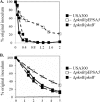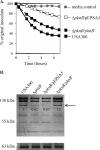Role of PknB kinase in antibiotic resistance and virulence in community-acquired methicillin-resistant Staphylococcus aureus strain USA300
- PMID: 20547748
- PMCID: PMC2916262
- DOI: 10.1128/IAI.00296-10
Role of PknB kinase in antibiotic resistance and virulence in community-acquired methicillin-resistant Staphylococcus aureus strain USA300
Abstract
The regulation of cellular processes by eukaryote-like serine/threonine kinases is widespread in bacteria. In the last 2 years, several studies have examined the role of serine/threonine kinases in Staphylococcus aureus on cell wall metabolism, autolysis, and virulence, mostly in S. aureus laboratory isolates in the 8325-4 lineage. In this study, we showed that the pknB gene (also called stk1) of methicillin-resistant S. aureus (MRSA) strain COL and the community-acquired MRSA (CA-MRSA) strain USA300 is involved in cell wall metabolism, with the pknB mutant exhibiting enhanced sensitivity to beta-lactam antibiotics but not to other classes of antibiotics, including aminoglycosides, ciprofloxacin, bactrim, and other types of cell wall-active agents (e.g., vancomycin and bacitracin). Additionally, the pknB mutant of USA300 was found to be more resistant to Triton X-100-induced autolysis and also to lysis by lysostaphin. We also showed that pknB is a positive regulator of sigB activity, resulting in compromise in its response to heat and oxidative stresses. In association with reduced sigB activity, the expression levels of RNAII and RNAIII of agr and the downstream effector hla are upregulated while spa expression is downmodulated in the pknB mutant compared to the level in the parent. Consistent with an enhanced agr response in vitro, virulence studies of the pknB mutant of USA300 in a murine cutaneous model of infection showed that the mutant was more virulent than the parental strain. Collectively, our results have linked the pknB gene in CA-MRSA to antibiotic resistance, sigB activity, and virulence and have highlighted important differences in pknB phenotypes (virulence and sigB activity) between laboratory isolates and the prototypic CA-MRSA strain USA300.
Figures








Similar articles
-
The arginine catabolic mobile element is not associated with enhanced virulence in experimental invasive disease caused by the community-associated methicillin-resistant Staphylococcus aureus USA300 genetic background.Infect Immun. 2009 Jul;77(7):2650-6. doi: 10.1128/IAI.00256-09. Epub 2009 Apr 20. Infect Immun. 2009. PMID: 19380473 Free PMC article.
-
Community-acquired meticillin-resistant Staphylococcus aureus strain USA300 resists staphylococcal protein A modulation by antibiotics and antimicrobial peptides.Int J Antimicrob Agents. 2015 Jan;45(1):19-24. doi: 10.1016/j.ijantimicag.2014.08.009. Epub 2014 Oct 2. Int J Antimicrob Agents. 2015. PMID: 25450803
-
Demography and Intercontinental Spread of the USA300 Community-Acquired Methicillin-Resistant Staphylococcus aureus Lineage.mBio. 2016 Feb 16;7(1):e02183-15. doi: 10.1128/mBio.02183-15. mBio. 2016. PMID: 26884428 Free PMC article.
-
The impact of serine/threonine phosphorylation in Staphylococcus aureus.Int J Med Microbiol. 2010 Feb;300(2-3):137-41. doi: 10.1016/j.ijmm.2009.08.016. Epub 2009 Sep 23. Int J Med Microbiol. 2010. PMID: 19783479 Review.
-
Basis of virulence in community-associated methicillin-resistant Staphylococcus aureus.Annu Rev Microbiol. 2010;64:143-62. doi: 10.1146/annurev.micro.112408.134309. Annu Rev Microbiol. 2010. PMID: 20825344 Review.
Cited by
-
Virulence strategies of the dominant USA300 lineage of community-associated methicillin-resistant Staphylococcus aureus (CA-MRSA).FEMS Immunol Med Microbiol. 2012 Jun;65(1):5-22. doi: 10.1111/j.1574-695X.2012.00937.x. Epub 2012 Mar 5. FEMS Immunol Med Microbiol. 2012. PMID: 22309135 Free PMC article. Review.
-
Resisting resistance: gearing up for war.Medchemcomm. 2019 Aug 7;10(9):1512-1516. doi: 10.1039/c9md00330d. eCollection 2019 Sep 1. Medchemcomm. 2019. PMID: 31803398 Free PMC article. Review.
-
GW779439X and Its Pyrazolopyridazine Derivatives Inhibit the Serine/Threonine Kinase Stk1 and Act As Antibiotic Adjuvants against β-Lactam-Resistant Staphylococcus aureus.ACS Infect Dis. 2018 Oct 12;4(10):1508-1518. doi: 10.1021/acsinfecdis.8b00136. Epub 2018 Aug 15. ACS Infect Dis. 2018. PMID: 30059625 Free PMC article.
-
Kinase Inhibitors that Increase the Sensitivity of Methicillin Resistant Staphylococcus aureus to β-Lactam Antibiotics.Pathogens. 2015 Oct 22;4(4):708-21. doi: 10.3390/pathogens4040708. Pathogens. 2015. PMID: 26506394 Free PMC article.
-
In Staphylococcus aureus the regulation of pyruvate kinase activity by serine/threonine protein kinase favors biofilm formation.3 Biotech. 2015 Aug;5(4):505-512. doi: 10.1007/s13205-014-0248-3. Epub 2014 Sep 12. 3 Biotech. 2015. PMID: 28324552 Free PMC article.
References
Publication types
MeSH terms
Substances
Grants and funding
LinkOut - more resources
Full Text Sources
Other Literature Sources
Medical
Research Materials
Miscellaneous

